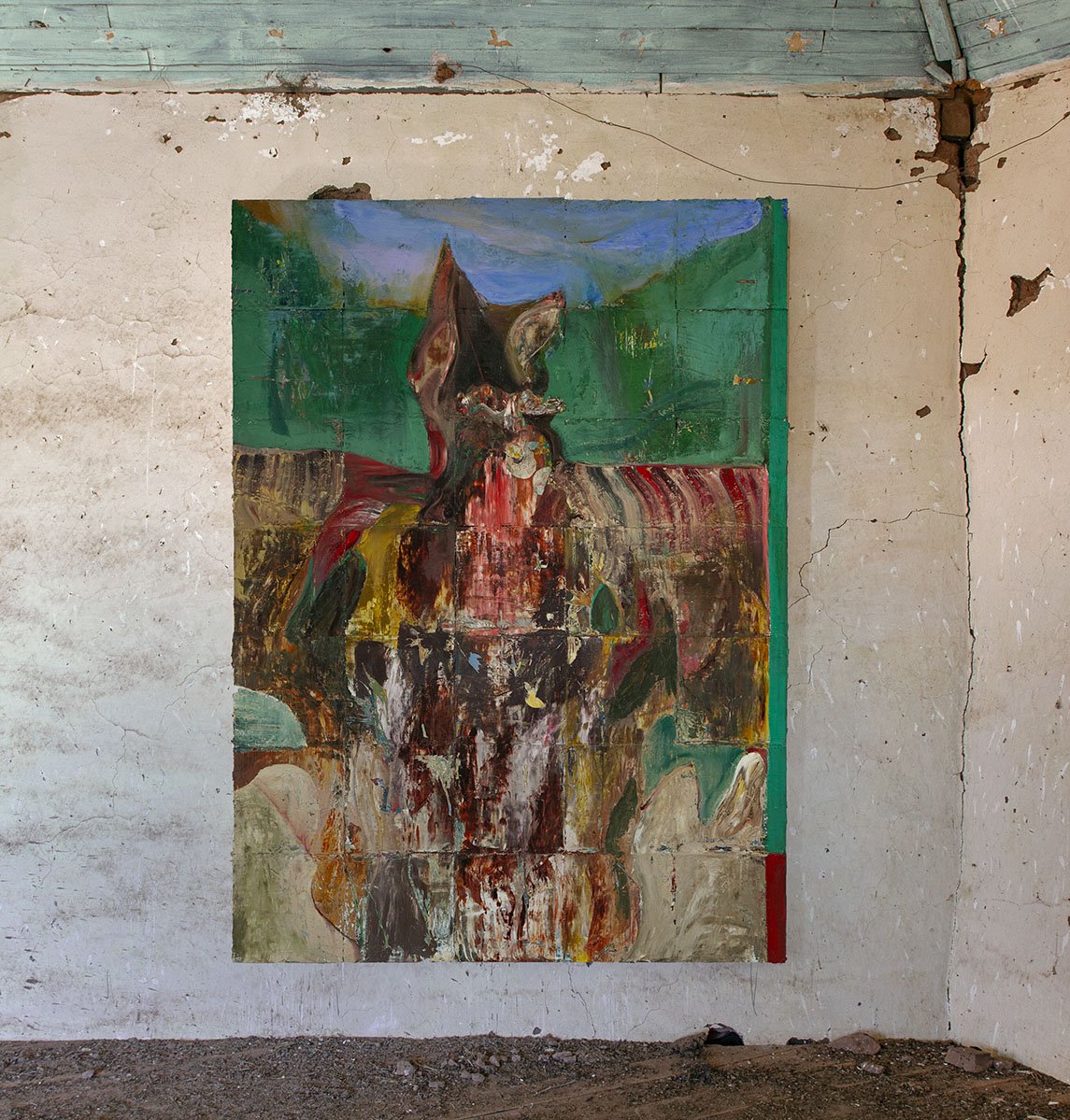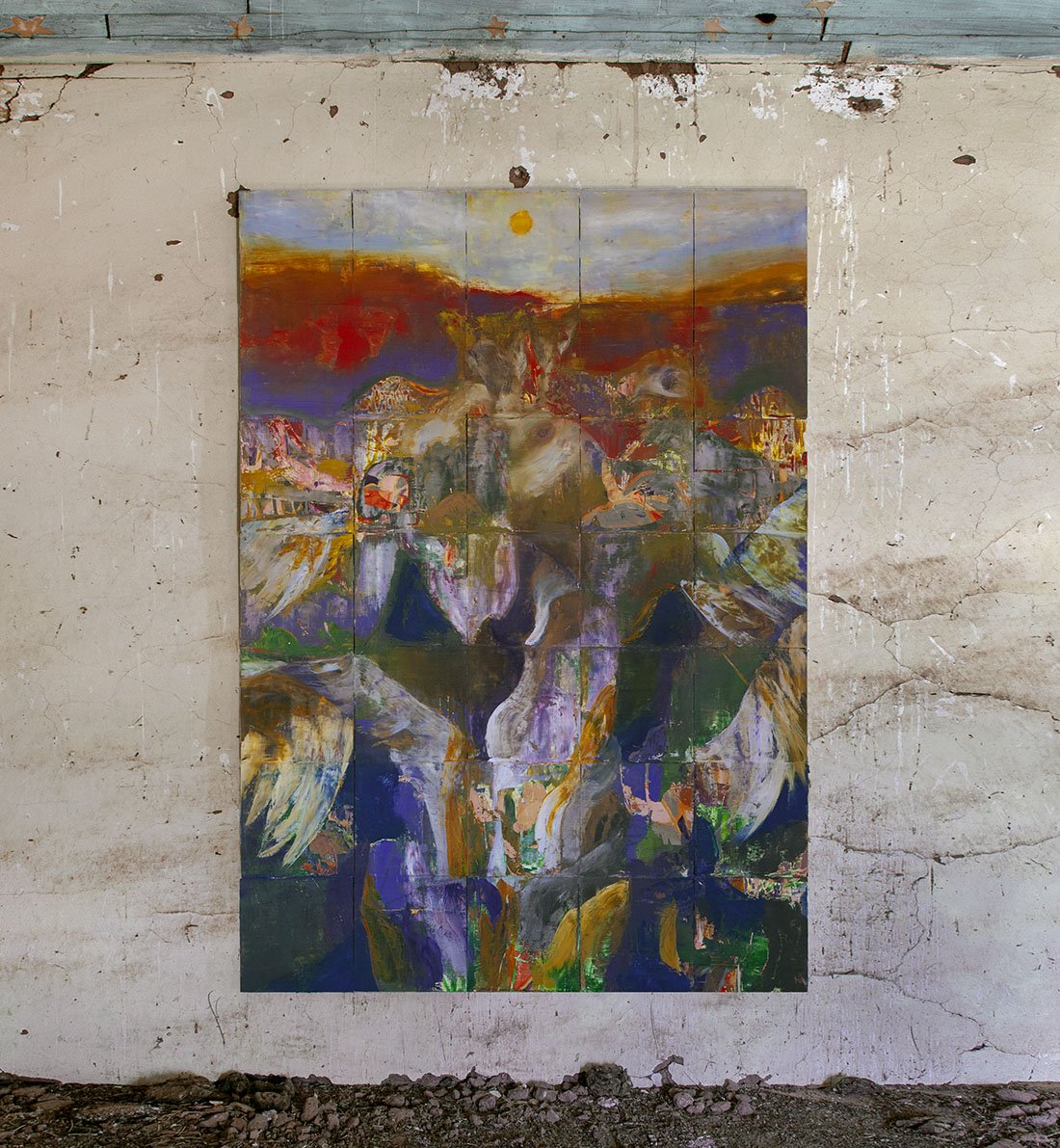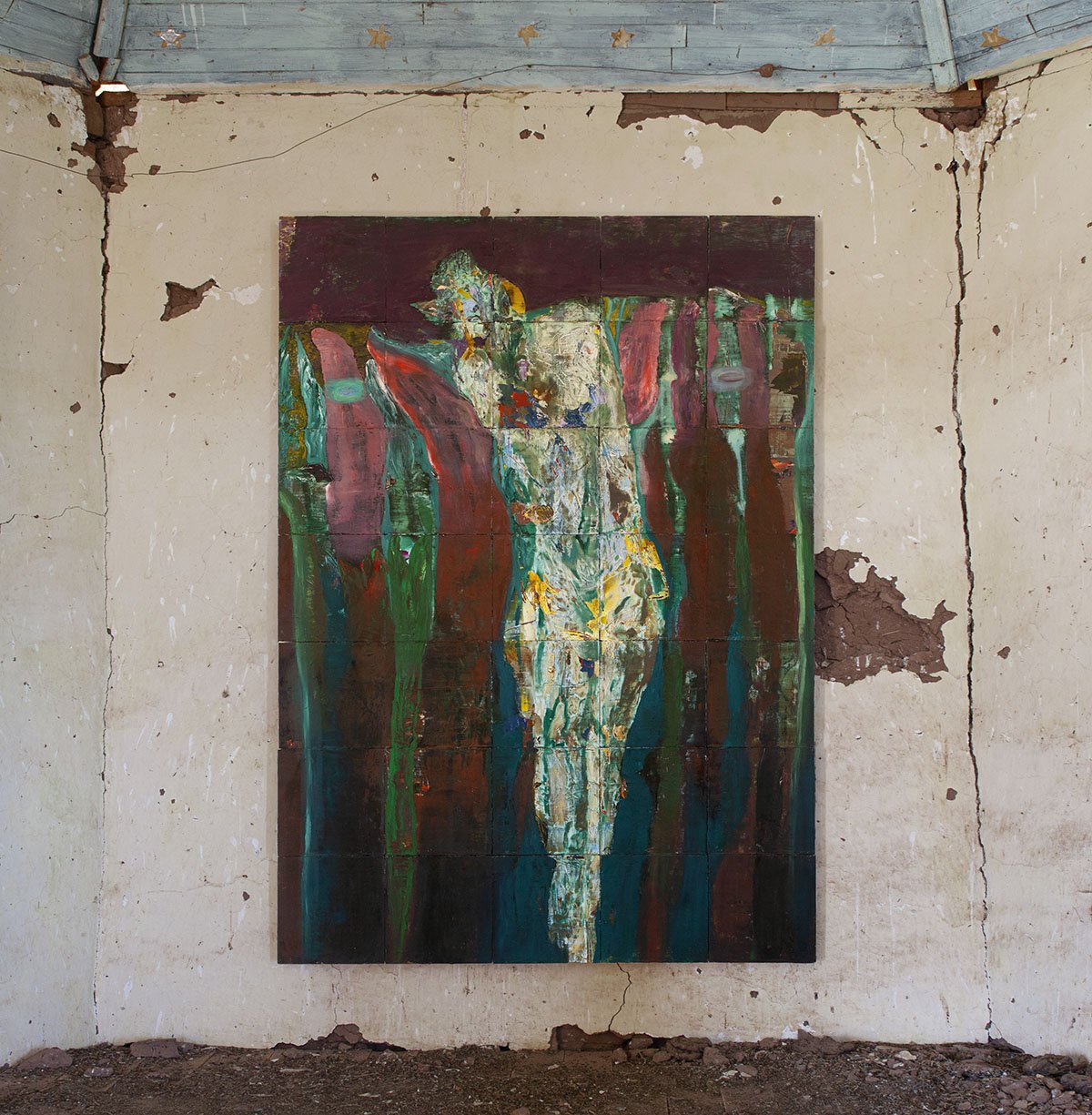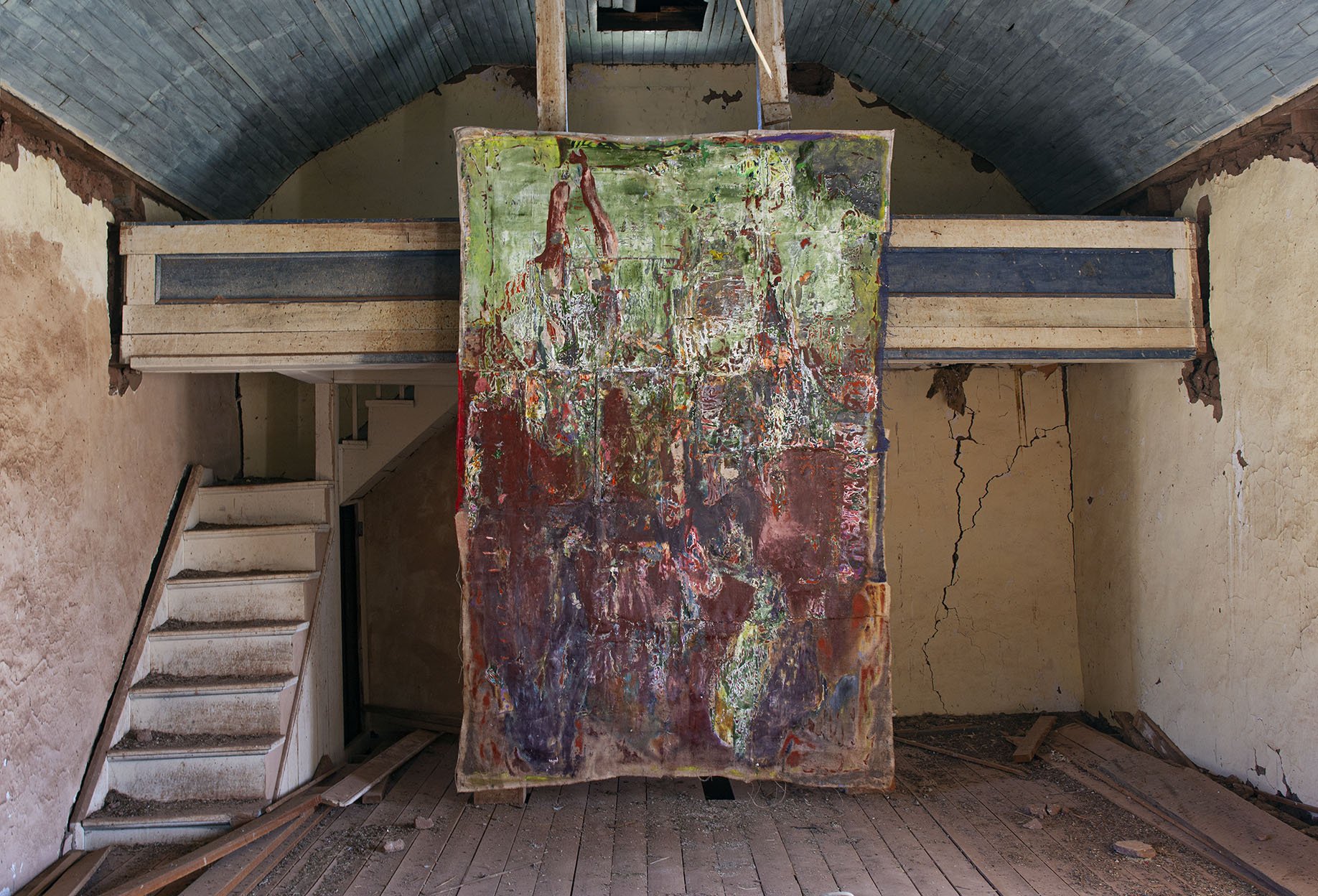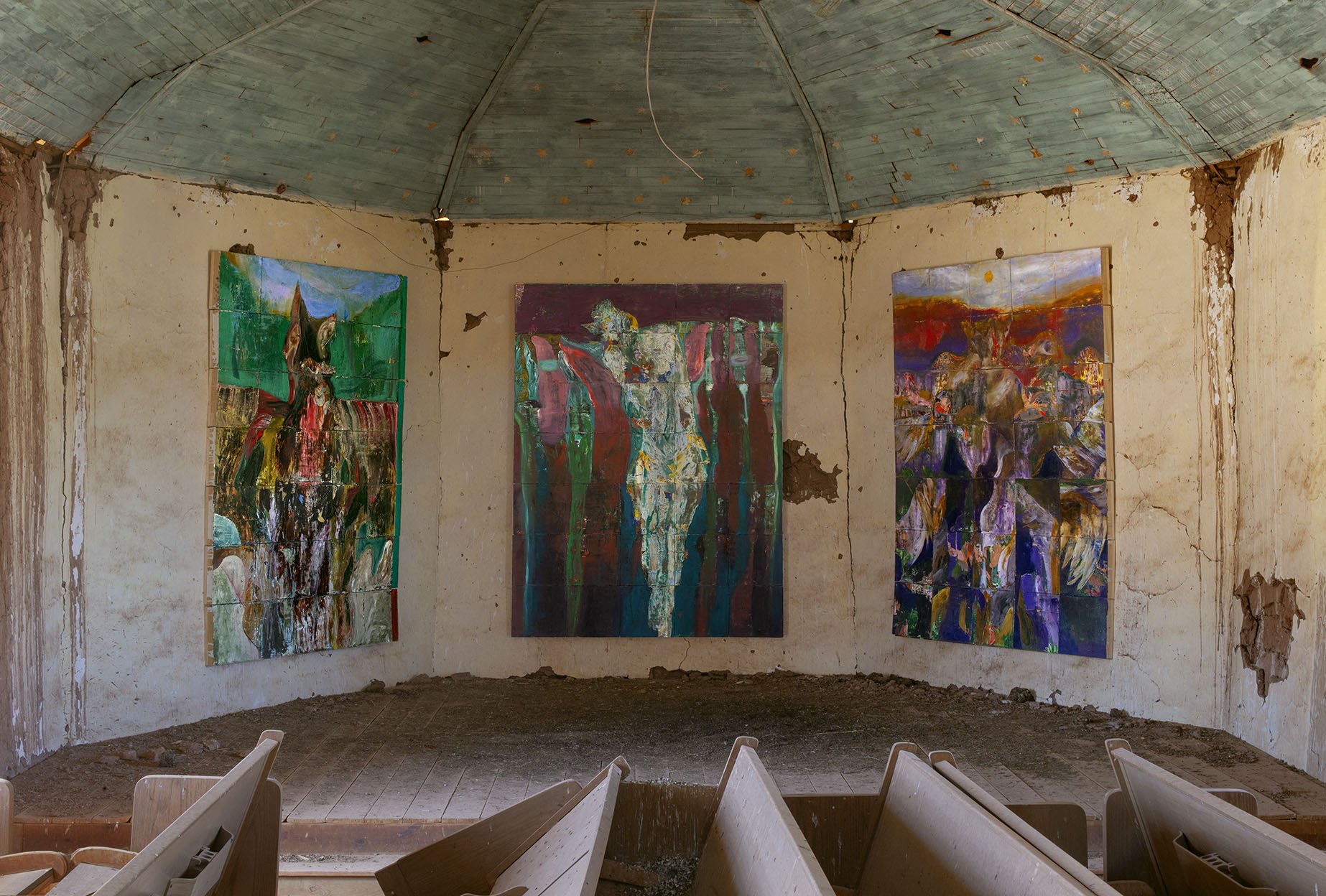Nihil: Summer Triangle
The Summer Triangle installed in an abandon church near Las Vegas, New Mexico.
Wildfires burning throughout the state of New Mexico.
During the hot, windy spring of 2022, much of New Mexico burned. From our front yard, we watched daily as smoke from the fires in the Jemez Mountains filled the northern sky. Our home itself is located at the foot of the Sandia Mountains, just south of us. Daily, I wondered: If wildfires are happening everywhere else, how long before it happens here?
Among the many fires in New Mexico at the time, the largest of them (the largest on state record), raged near the town of Las Vegas, which just so happens to sit on the Nihil route, the tree-shaped route through New Mexico I created at the outset of the project about a year before the fires began. All work made for the Nihil project must be made from direct experience with the areas on the route. Though there were many other fires, none of them were directly on the Nihil route. Thus, it was only the Las Vegas area I could approach.
My friend, the great painter and sculptor Cedra Wood, lives nearby and volunteered to guide me through the area as we attempted to approach the fires. Though checkpoints marking evacuation zones sensibly prevented us from getting within the vicinity, smoke was everywhere to be seen, and planes and helicopters flew in lines filling with water in nearby Lake Isobel and circling back and pour it on the fire. We drove into encampments where firefighters and volunteers lived for the duration. Everywhere we went, I sketched.
Among the sites Cedra showed me was a nearby abandoned church, as she knew I had a great interest in them. In New Mexico, these are not rare; Catholicism has long been a major part of the regional culture. The roads there were difficult, best taken with off-road capable vehicles, but the valley they dipped into was among the most beautiful and idyllic one could hope to encounter. Some ways down into the valley, an old forgotten mud church appeared. In an instant, I knew I would make my third installation in the Nihil series here. Some five months later, I did.
Abandon church near Las Vegas, New Mexico (Side View).
Abandon church near Las Vegas, New Mexico (Front View).
The church has different obstacles than other spaces I’ve worked in. The most obvious and immediate is that a single glassless window presents the only passage in or out. Doorways are boarded, and though it’s possible to remove them, I am reluctant do make myself more conspicuous than necessary when helping myself to buildings and areas I don’t know enough about.
The trouble, at the outset, was that I wanted to make a triptych for the apse (or, in any case, the area where the altar would likely to have once been situated). Measuring the three walls comprising its arc, it was clear that three five-by-seven-foot paintings would be ideal. Yet, the only way to get something that size into the church would be either to create something that could come apart in many small pieces, or something on paper or fabric that could be rolled tightly enough to fit through. That became my task: to make work that could do both.
Interior view of an abandon church near Las Vegas, New Mexico.
The absurdity of the task appealed to me, and I delighted in the surprises and challenges of the Nihil project, even as I sought to make work based on sketches around the fires, which had brought about much anxiety in myself and many folks I knew throughout the state.
The first of the works I began was “A Friend Who Waits Before a Bridge Leading into Fire (Vega, I Dreamt I Saw You),” painted on 35 individual square-foot wood panels. These made the math easy for something measuring five-by-seven feet and were guaranteed to fit through the window. I had no agenda in terms of a subject and naturally began by referencing the sketches I made of the fires. As is often the case in my work, I began creating intermittent layers that would stick without binding permanently to the surface, so that as they were added, they could be scraped out again. When nothing seemed to work, I began looking at the sketches I’d made of religious icons and of Cedra herself. What would become important to the piece is that my drawings of Cedra were made while she sat at the foot of a bridge, which marked a boundary between us and the nearby evacuation zone. Behind her, in the mountains, the fires swallowed acre after acre of forest. What began as a landscape painting of sorts was now turning figurative even as I scraped out layer after layer of legible imagery.
A Friend Who Waits before the Bridge Leading into Fire (Vega, I Dreamt I Saw You) | Mixed Media on 35 Wood Panels | 84 x 60 in. | 2022
While the fires persisted throughout the state, and I continued work in the studio, I was not well health-wise. My preoccupation with problems stemming from this condition made the painting difficult. I suffered much anxiety. Each day, I worried about our own nearby mountains catching fire, though this was not much more than a projection of other things which worried me more immediately.
I am someone who sees words, different, for example, from my wife Maja who sees colors and shapes. Nihil, for example, was a word hovering in my mind’s eye day after day, a year or so prior. I began seeing the word “Vega” each day as I worked on the painting. It seemed to come out of the word “Las Vegas.” And in recent days, Maja had been explaining the vagus nerve, the main nerve in the parasympathetic nervous system, which controls things like digestion, heart rate, and the immune system. Many of the symptoms I’d been having, she suggested, seemed to be connected to the vagus nerve, specifically that when it’s under stimulated, one is more susceptible to falling into a cycle of conditions responsible for the very symptoms I was experiencing.
After about three days of seeing the word Vega, I had a panic attack, which disabled my ability to speak reliably or, for a while, even to stand on my feet. I had something of an out-of-body experience in which it felt as if I had no interior, as if I were hollow, merely a shed skin or exoskeleton, but otherwise empty, and I could smell something awful, which I somehow associated with death itself. It was as if an inner self had been violently ripped from out of an outer self.
In the emergency room, I was unable to answer the simplest questions from nurses and doctors, such as my name and address, and sobbed when I tried. Simple movements were impossible. I rested there for the rest of the day until I was able to begin responding to questions. At the end of the day, I simply went home.
For the next three days afterward, I experienced what I can only describe as euphoria, and genuinely wondered if I was bipolar. The question in the air, though, didn’t particularly bother me, and the rest of the painting came quickly and easily. Afterward, life resumed, and I felt like myself, not euphoric, though better somehow, and lighter than before. I began to think of the whole episode as a kind of necessary exorcism, and a warning, somehow responsible for expediting a transformative process, bringing forward a potentiality which had been bottlenecked for too long.
Interior view of an abandon church near Las Vegas, New Mexico.
Because of one of the nine tenets of Nihil, the Tenet of Non-Meaning, I cannot begin a piece with a concept or theme; the work cannot begin with narrative intent or with something like political content or theory. Yet among the many great lessons to come out of the Nihil endeavor is that meaning is not absent from the world but ubiquitous and inevitable. This would seem to contradict the very meaning of Nihil, but I have reason to believe it doesn’t.
There is a felt paradox in the relationship between suspending one’s assumptions and presuppositions—which is to say the postponement of willful meaning making—and the proliferation of synchronicity in one’s individual relation to the world. Meaning, for me, is to do with pattern recognition. Yet to bring or deliver meanings into our experiences at the outset, limits our ability to recognize patterns apart from our usual thinking about the world. If existence could be said to be intrinsically meaningful, I can only know that for myself if I don’t insist that it must be. In other words, meaning will always conform to my usual shadow projection, and nothing more. Too coincidentally, it will tend to confirm what I already believe I know. Until I let go of the need for the world be intrinsically meaningful, I cannot discover the meaning of my unique relation to the world. A meaningful world ought to seem deeply and enigmatically ironic if it is to be taken as meaningful at all.
A Friend Who Waits before the Bridge Leading into Fire (Vega, I Dreamt I Saw You) (Detail)
In “Vega…” there are many welcome coincidences. The central figure, leaving behind any resemblance of my friend Cedra or of the fire itself, appears vaguely birdlike, and was unplanned as such. The coincidence was a simple result of the process and of trying to bring balance to its chaos. It was a great delight, as I began looking into the word Vega, to learn that it is a star, which, in middle- and far-eastern mythologies is usually represented as an eagle or vulture. Because of the stars displayed near the ceiling in the church, I liked discovering that Vega is an actual star. In the Arabic etymology of the word, it carries the meaning “to fall,” and that felt significant as well, given it’s in fact what I did.
After further research, I discovered that the star Vega is one of three stars comprising the Summer Triangle, not a constellation but an asterism, formed along with the stars Altair and Deneb. These three bright stars from the Lyra, Aquila and Cygnus constellations respectively, are visible in the low eastern sky during summer; the stars, in general, are usually quite visible at night from my small high desert community.
In Chinese mythology, Altair and Vega were long-ago lovers permitted to meet again only once every eon through the mediation of Deneb. Both Altair and Vega are represented as appearing birdlike. Of course, in my own cultural heritage, one can never think of the three points of a triangle without thinking of the holy trinity. None of these specific myths or narratives had to do with the way my own Summer Triangle came into being, yet, reflecting on the panic attack, I could not escape the irreconcilable sense of splitting between ego and soul (or whatever words best approximate the dilemma), that one of these should always feel broken or suppressed in order that the other might freely operate. Without a language to describe this sense of splitting, it long felt as if I were searching for a missing piece that could allow the two to reconcile.
A Friend Who Waits before the Bridge Leading into Fire (Vega, I Dreamt I Saw You) (Detail)
Detail of the ceiling in an abandon church near Las Vegas, New Mexico.
Though the panic attack didn’t magically cure this dilemma, it has absolutely cleared a path to reconciliation, and, in that sense, I can’t help thinking of Deneb. Deneb: the fire that burned away the blockage to allow Altair and Vega to reconcile. To give names to the many parts of a larger process, I think, is a basic human proclivity embedded in all of mythology. It’s an instinct I find helpful for meeting suffering, for giving it value and esteem, for making friends with our “internal alarm system” forcing attention on the need to bring things back into balance. Deneb, it seems to me, was a kind of gift, an attack and release, expediting a necessary surrender as preparation for identity reformation.
A Friend Who Waits Beyond the Bridge Swallowed by the Fire (Altair, I Dreamt I Saw You) | Mixed Media on 35 Wood Panel | 84 x 60 in. | 2022
The wonderful thing about titling the Vega piece first is that it literally describes a moment by a bridge with my friend Cedra on a day in which we were chasing fire. Yet, once the literal imagery vanishes, what we’re left with is a title indicating something more symbolic or universal. Each of the other paintings were made in the same manner. “Altair…” was created by looking at sketches I made on a day out on the Nihil route with my friend and studio manager Sam Staffan, as we scoured the countryside and wilderness in the aftermath of the fire. And just as the imagery of the fire and of Cedra disappeared, so too did the images of the aftermath and of Sam. I was certainly conscious of the star Altair by that time, and of the bird imagery tied to its myth, but I did not begin by insisting that it would take on such imagery. In fact, I thought perhaps I could make two abstract pieces that could bookend “Vega” as a central piece. Yet the painting came easily, was birdlike, and took on a similarly symbolic title, “A Friend Who Waits Beyond a Bridge Swallowed by the Fire (Altair, I Dreamt I Saw You)”
Once that painting was completed, it was obvious what the third required: a central figure which would display between the two, implicitly capable of reconciling them. Now I had a meaningful narrative, enlivening for me as the painter, but not as a pronouncement or justification conveyed to a viewer. In Nihil there is no audience except for a hypothetical individual who materializes at the right place and time, who has the power to bring it back into the world by seeing it for the first time. (The art world, as a kind of web of institutions and attitudes, is something which I’ve had to inwardly disavow for the sake of my own continuance.) For among the many reasons that “Nihil” became a guiding dogma for making the work is what twenty years’ experience as a working artist has taught me: that no message is ever understood unless it’s made to be so obvious that it’s not worth delivering. Obviousness, I’ve also learned, is only ever a lie, often ideological in nature, or, at the very least, a simple accident of narcissism.
A Friend Who Waits Beneath a Bridge Setting it on Fire (Deneb, I Dreamt I Saw You) | Mixed Media on 35 Wood Panels | 84 x 60 in. | 2022
The central painting (the final completed) is most legible, I think, because the crucified Christ is indelible to the culture. This image was not contained in earlier layers, and I did not know it would sit on top. I mention this because I do not intend it as a message to a public, either from the perspective of a believer or skeptic. This is not a matter that matters to me. It’s a non-coincidence, here in New Mexico, that I find so much Catholic imagery everywhere I go. The top layer of the “Deneb” piece comes from studies I made from a very old, very small statue of Christ I found in Corrales, which is missing its arms. I called it, “A Friend Who Waits Beneath a Bridge Setting it on Fire (Deneb, I Dreamt I Saw You).”
The first time I saw the three works together at the same time was in the church where these photos were taken. I did not know the sum of what I’d made until now. They seem to me not so much a triptych but an…asterism. They come from their own worlds, but they can be seen together. By not insisting on them as a triptych, they will likely go their own ways again, and in their own times.
The impetus for my own thinking on how to organize the Nihil structure came from the musical compositions of Estonian composer Arvo Part, and specifically from his signature tintinnabuli system. In tintinnabuli, two “voices” the T-voice (triad) and M-voice (melodic) move in relation to the other. Their movement is determined mathematically so that one voice moves above or beneath the next as a result of a set of conditions. For Part, there is theological significance in their relationship, to do with sin and forgiveness, as an Eastern Orthodox artist who understands this in a subtle and sophisticated way.
“One line,” explains Part, “[the M-voice] is who we are, and the other line [the T-voice] is who is holding and taking care of us.”
Early in Nihil I tried to make a mirror-image translation of notes to color, but it didn’t work as well as I’d hoped. Eventually, I let go of needing it to function directly. Still, throughout the process of making a work, or a group of works, I listen to Part’s music often and look for opportunities for there to be visual translations. This sometimes happens in the layering process, on the palette, or even in the quality of movement or touch.
So it’s almost comical that it never occurred to me until the installation was finished that I had set up a direct relationship between the T-voice and M-voice; across from the Summer Triangle works displays an unstretched, free-hanging fabric piece. As the window would only allow works comprised of smaller components or work that could be rolled, I decided to make this piece to hang from the clearstory on the opposite end of the nave. The work appears as the M-voice to the Summer Triangle’s T-voice. And just as the T-voice implicitly holds the M-voice, this large abstract work acts almost as the inner life of the outer narrative of the three stars.
After the Fire (After the Flood Afterlife After Mud After Veil After Shroud After the World After the Crowd) | Mixed Media on Cotton Drop Cloth and Burlap | approx. 120 x 80 in. | 2022
The piece is called, “After the Fire (After the Flood, Afterlife, After Mud, After Veil, After Shroud, After the World, After the Crowd).” As with the other words and titles, it came to me all at once as in a single line.
It was made from layers referencing my sketches of the fires’ aftermath. Its look is, in part, to do with the material on which it’s made. Although it appears to be canvas, it’s nothing more than a used cotton drop cloth, the sort which a house painter might use, and which was on the studio floor for a long time. It’s collaged together with scraps of burlap. These surfaces don’t really invite paint, and the simple task of getting it on the surface is not smooth or easy. When I scrape layers out, it subtracts strangely, and I could not predict what might happen at each stage. It is a painting which could not be made twice.
While traveling through the mountain forest with Sam near Las Vegas we stopped along the way to photograph the burnt trees and detritus of the many destroyed homes and other structures. A firefighter passing by stopped to chat with us. He explained that after all this devastation, the threat was not over. With all the fallen trees, the upcoming rains would cause flooding and erosion; far more homes would be lost before it was over, including his own.
Ruins of a burned down home near Las Vegas, New Mexico.
Detail of the ruins of a burned down home near Las Vegas, New Mexico.
I often have the odd sensation that the distinction between interior and exterior phenomena is a false one, that the experience of the individual body is mimetic to the experience of the landscape, and vice versa. Where memory is to be found in the mind of the individual, so it is to be found in the mountain forests, only to vanish from both. Where the landscape expands and contracts in relation to fires and floods and so on, so too does the body, and therefore the spirit, which is not separate. At times, it is as if both share a single consciousness. In the Nihil tenet of Place it’s stated that where I am is what I am. This experience of life, which is daily for me, leaves its traces in a piece like this.
The difference between an abstract work which is about nothing and one which is about everything, is not a difference, for it’s in the empty places that my loneliness is rewarded and nowhere else. These distinctions exist only in culture, as in a game of words, but is not to be found in the mundane and diaphanous things of nature. The traces of human activity left behind in the all-consuming fact of what nature is, is tragic certainly, and inevitable. But, also, it simply is.
Once, at a fancy dinner in New York, I was conversing with a prominant gallerist who has a kid my daughter’s age. I was reveling in how wonderful it is to realize that as we die, what was keeping us alive goes to our children, so that to embrace one’s own diminishment is also to offer our lives in exchange for theirs. They live because we die, and how can I respond to this except with gratitude? For now I have a way in which to embrace death.
He had a peculiar look on his face, as if I had spoiled the taste of his dinner, and I sensed I said too much again, as too often is the case. A friend and fellow artist on the other side of me, as his attention was diverted elsewhere, leaned in with a wry smile and whispered to me in her thick Italian accent. “Joshua,” she said, “in New York, nobody discusses death at dinner time.”
“Ah,” I thought to myself. “I look forward to dessert then.”
The Summer Triangle installed in an abandon church near Las Vegas, New Mexico.





